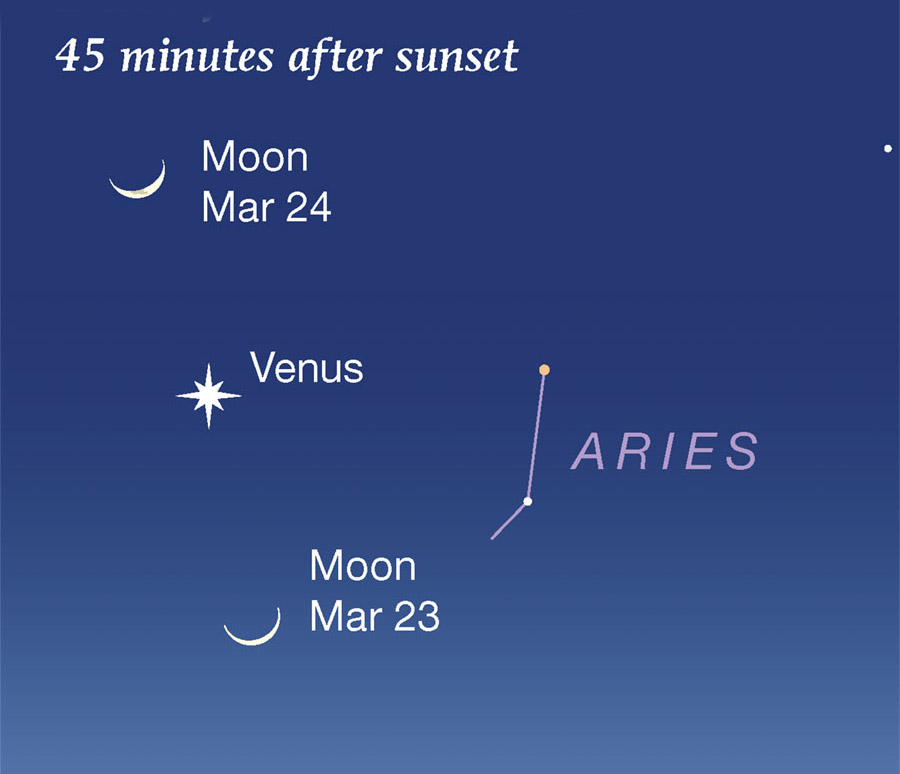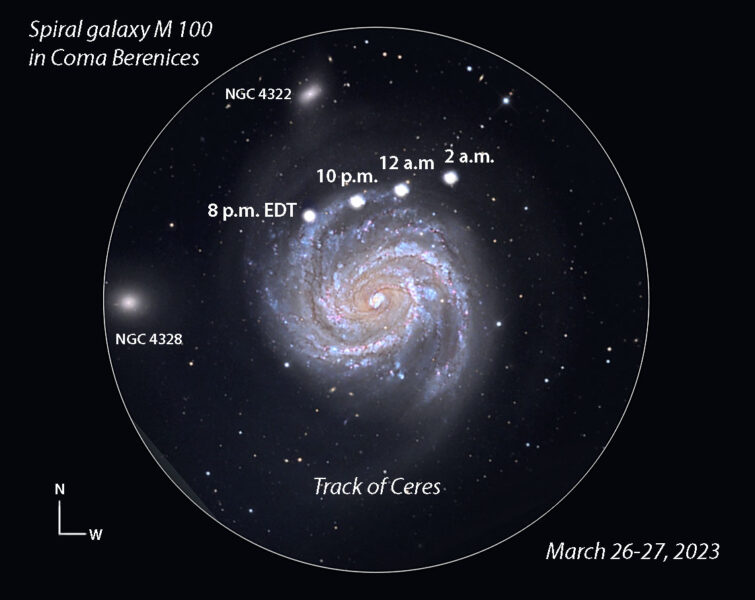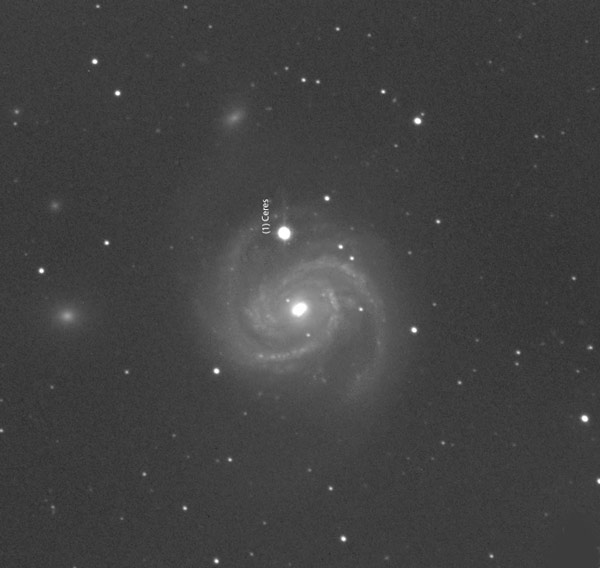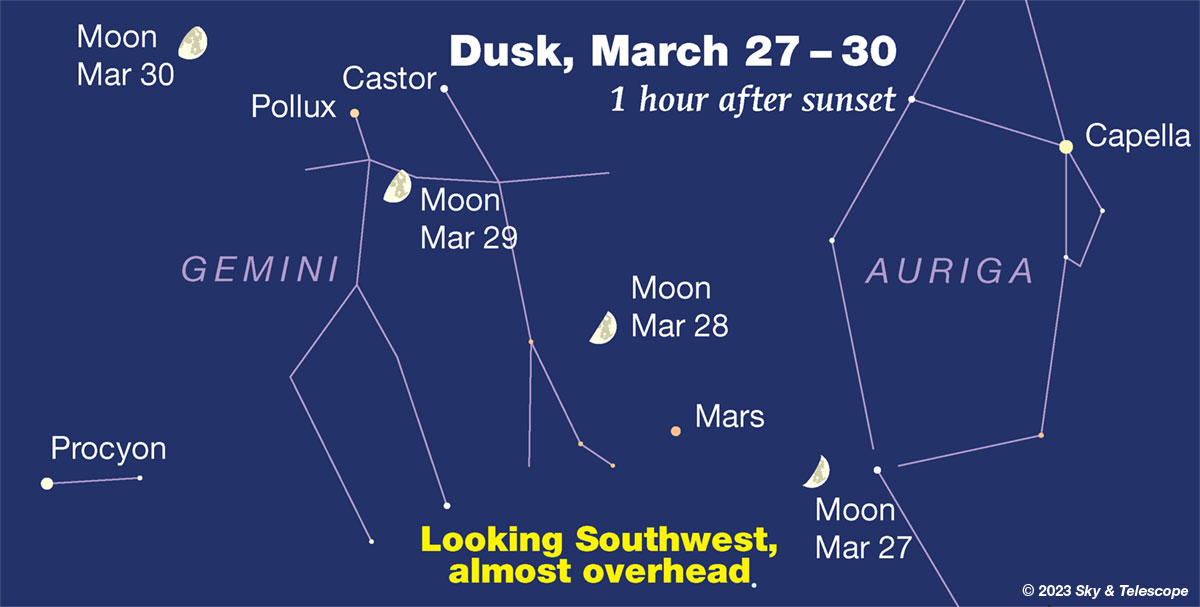FRIDAY, MARCH 24
■ The waxing crescent Moon hangs above Venus in the west this evening, as shown here.

■ The Big Dipper glitters softly high in the northeast these evenings, standing on its handle. You probably know that the two stars forming the front of the Dipper's bowl (currently on top) are the Pointers; they point to Polaris, currently to their left or lower left.
And, you may know that if you follow the curve of the Dipper's handle out and around by a little more than a Dipper length, you'll arc to Arcturus, now rising in the east.
But did you know that if you follow the Pointers backward the opposite way, you'll land in Leo?
Draw a line diagonally across the Dipper's bowl from where the handle is attached, and continue far on, to go to Gemini.
And look at the two stars forming the open top of the Dipper's bowl. Follow this line past the bowl's lip far across the sky, and you cruise to Capella.
SATURDAY, MARCH 25
■ Higher above Venus now, the crescent Moon shines just a couple degrees from the Pleiades.
■ As spring gets rolling, the signature fall-and-winter constellation Cassiopeia retreats down after dark. Look for it fairly low in the north-northwest. It's standing roughly on end.
But for skywatchers at mid-northern latitudes Cassiopeia is circumpolar, never going away completely. By 1 or 2 a.m. daylight-saving time it's at its lowest due north, lying not quite horizontally.
■ This is the time of year when the dim Little Dipper juts to the right from Polaris (the Little Dipper's handle-end) during late evening. The much brighter Big Dipper curls over high above it, "dumping water" into it. They do the reverse water dump in the fall.
SUNDAY, MARCH 26
■ This evening the asteroid 1 Ceres, 7th magnitude, crosses the northernmost spiral arm of the 10th-magnitude galaxy M100 in Coma Berenices, as shown below. Unlike how galaxies look in images, their low-surface-brightness arms and disc are generally much less visible in telescopes than their small, dense inner regions.


MONDAY, MARCH 27
■ Jupiter and Mercury are in conjunction very low in bright twilight, due west. Use binoculars starting about 20 minutes after sunset. Mercury is 1.3° to the right of brighter Jupiter.
■ The Moon this evening shines just left of 2nd-magnitude Beta Tauri and somewhat farther to the lower right of Mars.
■ Ceres is just past opposition and just past yesterday's transit of M100. Ceres glimmers at a binocular-friendly magnitude 7.0 in Coma Berenices, nice and high by late evening. See the article and finder charts in the March Sky & Telescope, page 48. And once you've identified Ceres, look for M100 now 0.2° east-southeast of it.

TUESDAY, MARCH 28
■ First-quarter Moon (exactly so at 10:32 p.m. EDT). Darkness finds the Moon hanging about 6° above Mars, the top corner of the temporary Orange Triangle. The triangle's other two corners (out of the frame above) are Betelgeuse to Mars's lower left and Aldebaran farther under Mars.
WEDNESDAY, MARCH 29
■ Now the high waxing gibbous Moon shines under Castor and Pollux, as shown above.
■ There's consequently a lot of moonlight in Gemini, but tonight Mars is passing just 1.2° north of the open cluster M35.
THURSDAY, MARCH 30
■ After dark, Sirius sparkles brightly in the south-southwest. Lower left of Sirius, by about one fist, is the triangle of Adhara, Wezen, and Aludra, from right to left. They form Canis Major's hind foot, rear end, and tail, respectively. Or, alternatively, the lower end and handle of the Meat Cleaver.
Just left or upper left of them, forming a 3rd- and 4th-magnitude arc, are the three uppermost stars of the constellation Puppis: the poop deck (stern) of the giant ancient constellation Argo Navis, the ship of Jason and the Argonauts. These three are the only stars of Argo that you can see fairly easily from mid-northern latitudes.
Just 1.5° upper right of the middle of the three, binoculars on a dark night will show the 6th-magnitude open cluster M93. It's elongated northeast-southwest.
FRIDAY, MARCH 31
■ There comes a time in late evening now when Arcturus, the bright Spring Star climbing in the east, stands just as high as Sirius, the brighter Winter Star descending in the southwest (for skywatchers at mid-northern latitudes). Their heights will balance sometime around 10 or 11 p.m. daylight-saving time, depending on both your latitude and longitude.
These are the two brightest stars in the sky at the time. But Capella is a very close runner-up to Arcturus! Spot it high in the northwest.
SATURDAY, APRIL 1
■ The waxing gibbous Moon shines in Leo, forming an isosceles triangle yet again with Regulus below it (in early evening) and Gamma Leonis (Algieba) to the Moon's left. The Moon is about 6° from each.
SUNDAY, APRIL 2
■ The Moon forms another nearly isosceles triangle with Regulus and Algieba, but now it's lower left and farther away from them.
■ The huge, bright Winter Hexagon is still in view early after dark, filling the sky to the southwest and west. It's the sky's biggest widely-recognized asterism.
Start with brilliant Sirius in the southwest, the Hexagon's lower left corner. High above Sirius is Procyon. From there look higher upper right for Pollux and Castor (lined up nearly horizontal), lower right from Castor to dim Beta Aurigae and then bright Capella, lower left from there to Aldebaran, lower left to Rigel at the bottom of Orion, and back to Sirius.
The Hexagon is somewhat distended. But if you draw a line through its middle from Capella to Sirius, the "Hexagon" is fairly symmetric with respect to that axis.
This Week's Planet Roundup
Don't be misled by media hype about a great lineup of planets shining in the west this week. Most people will only see Venus and, high above it, much-fainter Mars similar to stars in its general area. Mercury and Jupiter are very low in bright twilight and will likely need binoculars before they set. Uranus, near Venus, is invisible to the naked eye. See below for what really to look for!
Mercury and Jupiter are very low in the glow of sunset. Look due west about a half hour after sunset, far to the lower right of Venus. Binoculars will help. Jupiter is magnitude –2.0 and Mercury is not far behind: magnitude –1.5 on Friday March 24th, fading to –1.1 over the next seven days.
Jupiter sinks lower day by day, but Mercury shoots up! On the 24th Mercury is 6° to Jupiter's lower right and probably still out of sight. They pass each other at conjunction March 27th, with Mercury 1.3° to Jupiter's right. By Friday the 31st Mercury is 6° above Jupiter.
Venus (magnitude –4.0, in Aries) is the brilliant "Evening Star" shining in the west during and after dusk. It finally sets almost 2 hours after dark. Telescopically, Venus is a shimmering little gibbous ball 14 arcseconds in diameter and about 78% sunlit.
Mars has moved from Taurus to cruise over the trailing foot of the Castor stick-figure in Gemini. Look for it high in the southwest in early evening, lower in the west later. It's upper left of Venus by four or five fists at arm's length.
Mars continues to fade: from magnitude +0.8 to +1.0 this week. It's very similar to Mars-colored Aldebaran (+0.9) some 18° below it, and Mars-colored Betelgeuse (currently +0.4) about the same distance to Mars's lower left. They form the big, temporary Orange Triangle, no longer equilateral. It's connected to the larger, brighter Winter Triangle at its Betelgeuse corner.
In a telescope Mars is now just a little orange blob 6 arcseconds wide. That's too small to show details visually, but notice its gibbous shape: 90% sunlit.
Saturn is just emerging into dawn view, very low in the east-southeast as the sky brightens. Try binoculars about 40 minutes before sunrise.
Uranus, magnitude 5.8 in Aries, is in the west right after dark far in the background of Venus. Uranus finder charts are in last November's Sky & Telescope, page 49.
Neptune is hidden low in the sunrise.
All descriptions that relate to your horizon — including the words up, down, right, and left — are written for the world's mid-northern latitudes. Descriptions and graphics that also depend on longitude (mainly Moon positions) are for North America.
Eastern Daylight Time (EDT) is Universal Time minus 4 hours. UT is sometimes called UTC, GMT, or Z time.
Want to become a better astronomer? Learn your way around the constellations. They're the key to locating everything fainter and deeper to hunt with binoculars or a telescope.
This is an outdoor nature hobby. For a more detailed constellation guide covering the whole evening sky, use the big monthly map in the center of each issue of Sky & Telescope, the essential magazine of astronomy.
Once you get a telescope, to put it to good use you'll need a much more detailed, large-scale sky atlas (set of charts). The basic standard is the Pocket Sky Atlas (in either the original or Jumbo Edition), which shows all stars to magnitude 7.6.

Next up is the larger and deeper Sky Atlas 2000.0, plotting stars to magnitude 8.5; nearly three times as many. The next up, once you know your way around, are the even larger Interstellarum atlas (stars to magnitude 9.5) or Uranometria 2000.0 (stars to magnitude 9.75). And be sure to read How to Use a Star Chart with a Telescope. It applies just as much to charts on your phone or tablet as to charts on paper.
You'll also want a good deep-sky guidebook. A beloved old classic is the three-volume Burnham's Celestial Handbook. An impressive more modern one is the big Night Sky Observer's Guide set (2+ volumes) by Kepple and Sanner.
Can a computerized telescope replace charts? Not for beginners, I don't think, and not on mounts and tripods that are less than top-quality mechanically. And as Terence Dickinson and Alan Dyer say in their Backyard Astronomer's Guide, "A full appreciation of the universe cannot come without developing the skills to find things in the sky and understanding how the sky works. This knowledge comes only by spending time under the stars with star maps in hand."
![]() Audio sky tour. Out under the evening sky with your
Audio sky tour. Out under the evening sky with your
earbuds in place, listen to Kelly Beatty's monthly
podcast tour of the heavens above. It's free.
"The dangers of not thinking clearly are much greater now than ever before. It's not that there's something new in our way of thinking, it's that credulous and confused thinking can be much more lethal in ways it was never before."
— Carl Sagan, 1996
"Facts are stubborn things."
— John Adams, 1770
 2
2









Comments
misha17
March 24, 2023 at 1:00 pm
March 24: Today is a good day to try for a daytime sighting of Venus.
1. Go to heavens-above.com, enter your location in the upper right corner
2. Go to the "Moon" page, get the times for moonrise and moonset. Halfway between those times, the Moon will be due South.
3. Go out at that time, look for the Moon due South. Stand in the shadow of a building to block out the Sun.
4. Venus should be to its right, about the distance of a half-fist held at arm's length
You must be logged in to post a comment.
Rod
March 26, 2023 at 11:13 pm
I was able to view Ceres and M100 this evening. Observed 2045-2230 EDT. First Quarter Moon 29-March-2023 0232 UT. I enjoyed some views of Ceres and M100 close together in sky position tonight. Stellarium 1.2 for 2200 EDT showed the pair close to 16 arcminute angular separation. I did a star hop from 6 Com, HIP59941, HIP60210 right into Ceres asteroid. There was another distinct stellar asterism about 40 arcminutes from Ceres and M100. HIP60392, TYC1445-1697-1, TYC1445-1362-1, TYC1445-2397-1, HIP60566, HIP60621, HIP60672. These 7 stars ranged in apparent magnitude 6.71 - 9.84. Ceres 7.03 magnitude according to Stellarium 1.2. https://theskylive.com/, reported 6.94 apparent magnitude for tonight. I used my 90-mm refractor telescope, TeleVue 40-mm plossl (25x views) and TeleVue 32-mm plossl (31x views). M100 was difficult to pick out but doable tonight, small faint fuzzy near Ceres. My 10-inch with 2-inch eyepiece would do a better job but the 90-mm refractor worked. Weather while I viewed 8C, winds calm, clear skies. Spring is here, I was cutting grass in the afternoon before observing tonight.
You must be logged in to post a comment.
You must be logged in to post a comment.